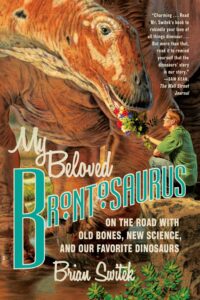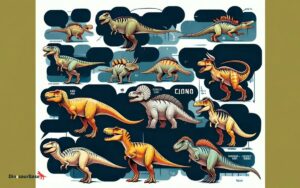How Did T. Rex Dinosaurs Live in Their Natural Habitat?
T. Rex dinosaurs thrived as apex predators in diverse ecosystems. They hunted prey and scavenged in lush forests and plains.
Exploring the life of the legendary Tyrannosaurus Rex, one of the most formidable creatures of the Cretaceous period, offers insight into the prehistoric world where these giants roamed.
T. Rex dinosaurs dominated their environment around 68 to 66 million years ago, adapting to various habitats from dense forests to open floodplains.
Their life entailed not just hunting and consuming large herbivorous dinosaurs but also competing with other predators and possibly partaking in complex social behaviors.
Biological evidence suggests these massive carnivores had incredible bite strength and keen senses, which helped them effectively locate and overpower their prey.
Their presence across what is now North America indicates they were both adaptable and widespread, solidifying their role as one of the prehistoric era’s most iconic dinosaurs.
Understanding how T. Rex dinosaurs lived provides a profound glimpse into Earth’s evolutionary history and the dynamic ecosystems of the late Cretaceous period.
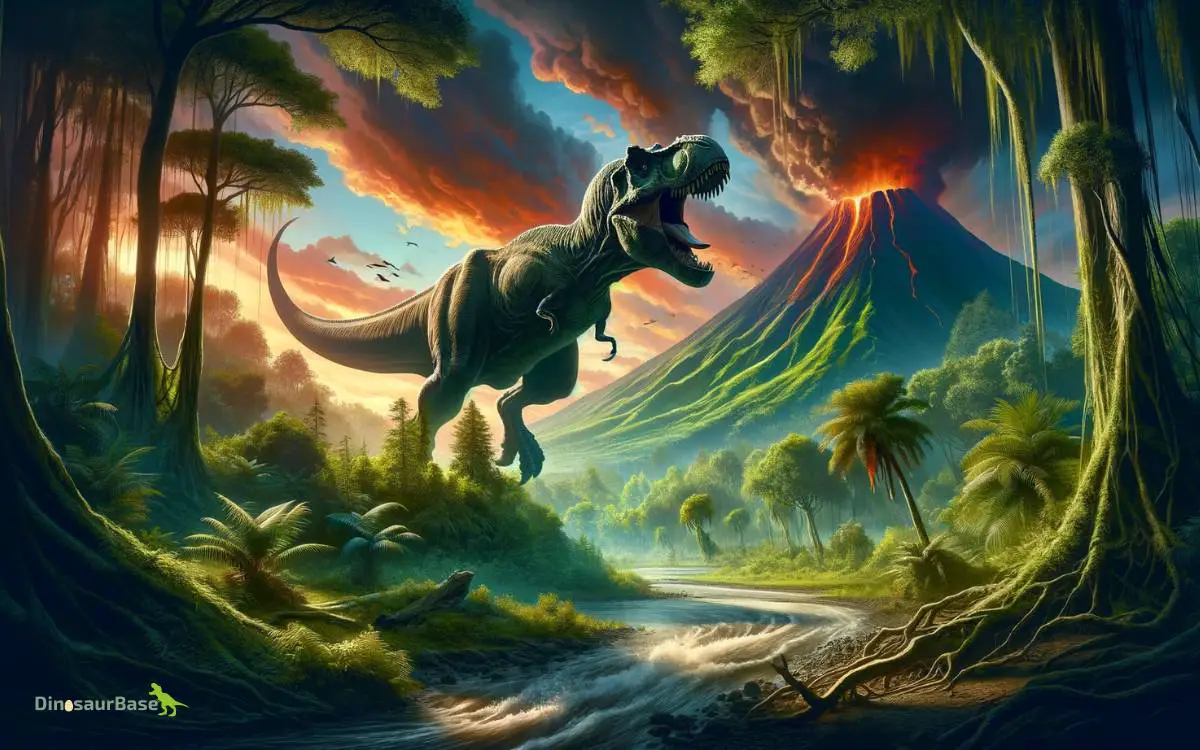
T. Rex Habitat And Environment
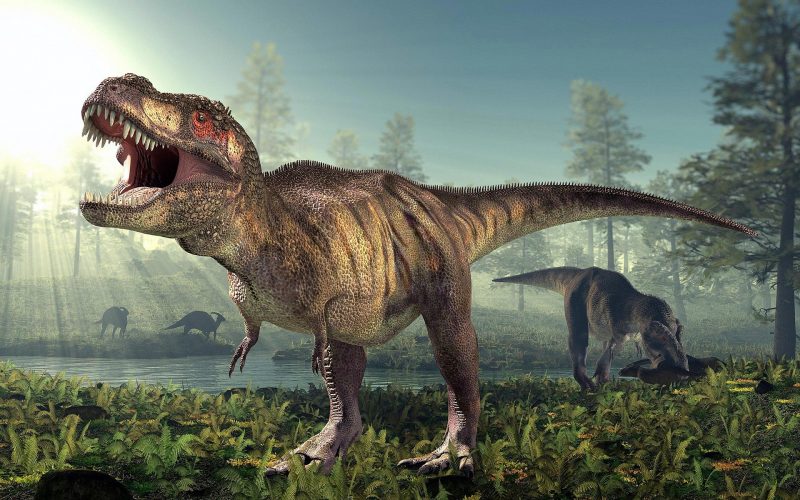
Credit: earthsky.org
Imagine a world where the mighty Tyrannosaurus rex roamed. These colossal creatures had specific needs from their surroundings to thrive.
In this section, we’ll explore the T. Rex habitat and environment, unveiling the ancient world these predators called home.
Prehistoric Landscapes And Climate
Dense forests and open plains made up the prehistoric landscapes that the T. rex dominated. These vast areas provided ample space for hunting and roaming. A warm and humid climate prevailed, with seasonal variations that these dinosaurs adapted to.
Key features of their landscape included:
- Abundant vegetation that supported a diverse ecosystem of prey.
- Rivers and water bodies that served as sources of water and potential hunting grounds.
- Volcanic activity, leading to fertile grounds promoting lush growth.
The environment had to support the immense size and dietary needs of the T. rex, hence its abundance and diversity were crucial.
Geographical Distribution Of Fossil Findings
Fossils of T. rex reveal a lot about where they lived. Most discoveries occur in North America’s upper Cretaceous formations. This suggests a wide range of habitats these dinosaurs could adapt to.
| Region | Number of Findings |
|---|---|
| Montana | Over 50 |
| South Dakota | 30+ |
| Wyoming | 20+ |
Interesting facts about the T. rex fossil spread:
- Findings are not just limited to land; some are near ancient sea beds.
- Rock formations from different periods show shifts in where T. rex lived.
- These shifts indicate their adaptability to changing environments over time.
Understanding the T. rex habitat and environment is like piecing together a prehistoric puzzle. Each new discovery adds to the snapshot of the world they lived in.

Credit: m.youtube.com
Physical Adaptations For Survival
The mighty T. rex boasted a range of adaptations that cemented its role as a fearsome predator. Its life in the Cretaceous period demanded specialized traits for hunting and survival.
Below, we delve into the T. rex’s physical adaptations, focusing on its anatomy for predation and unique mechanisms for thermoregulation and metabolism.
Anatomical Features For Predation
As a top predator, T. rex had features perfect for catching prey:
- Powerful Jaws: Its bite could crush bone, thanks to robust muscles.
- Sharp Teeth: Serrated, banana-sized teeth tore through flesh.
- Binocular Vision: This gave T. rex excellent depth perception.
- Massive Size: Its bulk intimidated and overpowered prey.
- Strong Legs: Built for ambush, these legs helped T. rex to sprint short distances quickly.
Thermoregulation And The Giant Reptile’s Metabolism
Surviving as a giant, the T. rex needed to regulate its body temperature:
- Large Body: Its size may have helped in maintaining a stable internal environment.
- Feathers: Speculated to exist in some T. rex fossils, feathers could have played a role in insulation.
- Active Metabolism: A high metabolism likely kept it warm and energetic.
These features allowed the T. rex to thrive in varying climates, ensuring its dominance over its habitat.
The T. Rex Diet
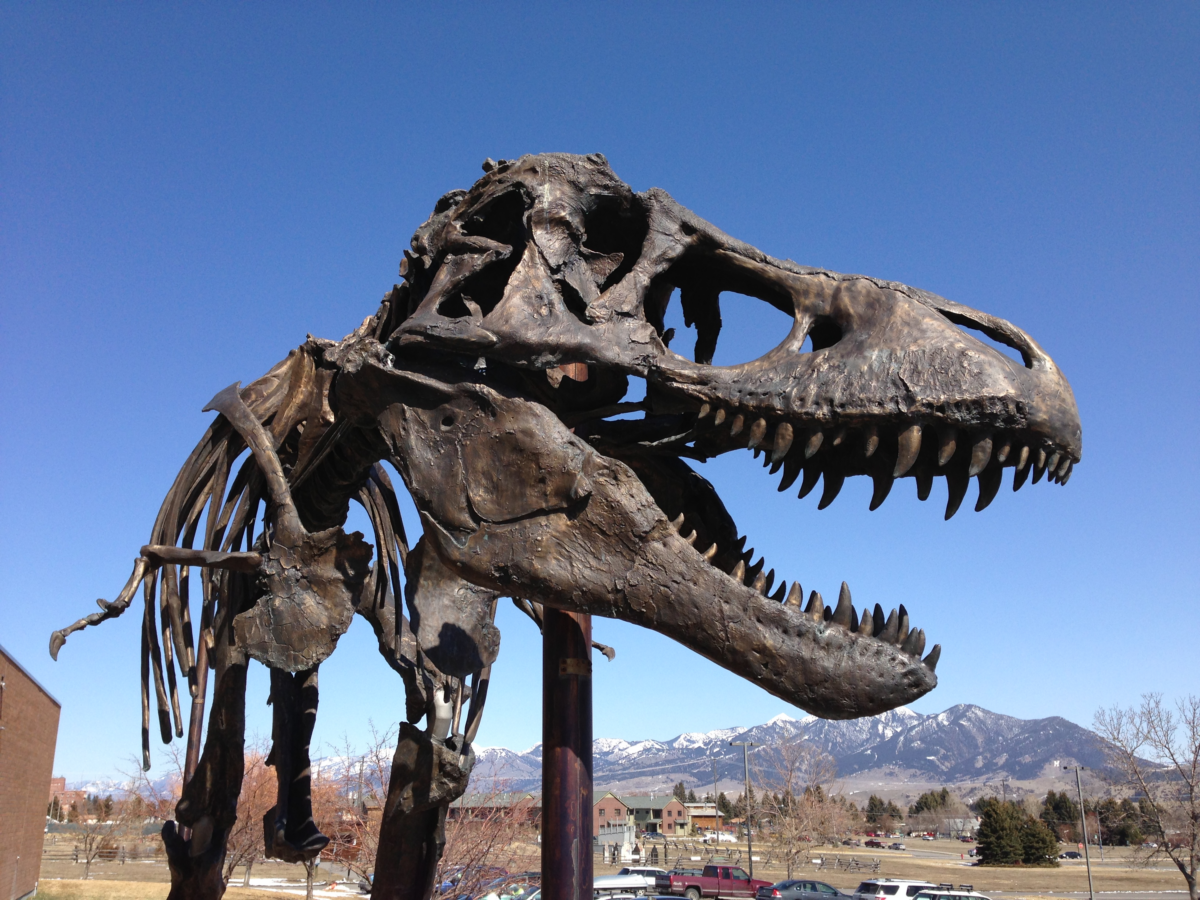
Imagine a world where the Tyrannosaurus rex roamed free. These giant predators needed plenty of food to fuel their massive bodies.
But what exactly did a T. rex eat to survive in its natural habitat? Let’s sink our teeth into the diet of the most fearsome dinosaur to have ever walked the Earth.
Predatory Behavior And Hunting Techniques
T. rex was not just powerful, but also a cunning hunter. Its hunting strategy has fascinated scientists for years.
- Keen senses to locate prey
- Strong legs for fast sprints
- Huge, sharp teeth to grip and tear
They likely ambushed their meals, using their incredible bite force to overpower other dinosaurs. Evidence suggests the T. rex might have hunted in packs, much like wolves do today. This made them even more successful at catching large prey.
Carrion Consumption And Scavenging Roles
Apart from hunting, T. rex also played the role of a scavenger. No leftovers went to waste in the time of the dinosaurs.
- Eating dead animals for quick meals
- Scaring off smaller predators from carcasses
- Flexibility in diet for survival
The versatility in their diet meant that even when the T. rex could not catch live prey, they could still feed on carcasses. This adaptability was key to their dominance during the Cretaceous period.
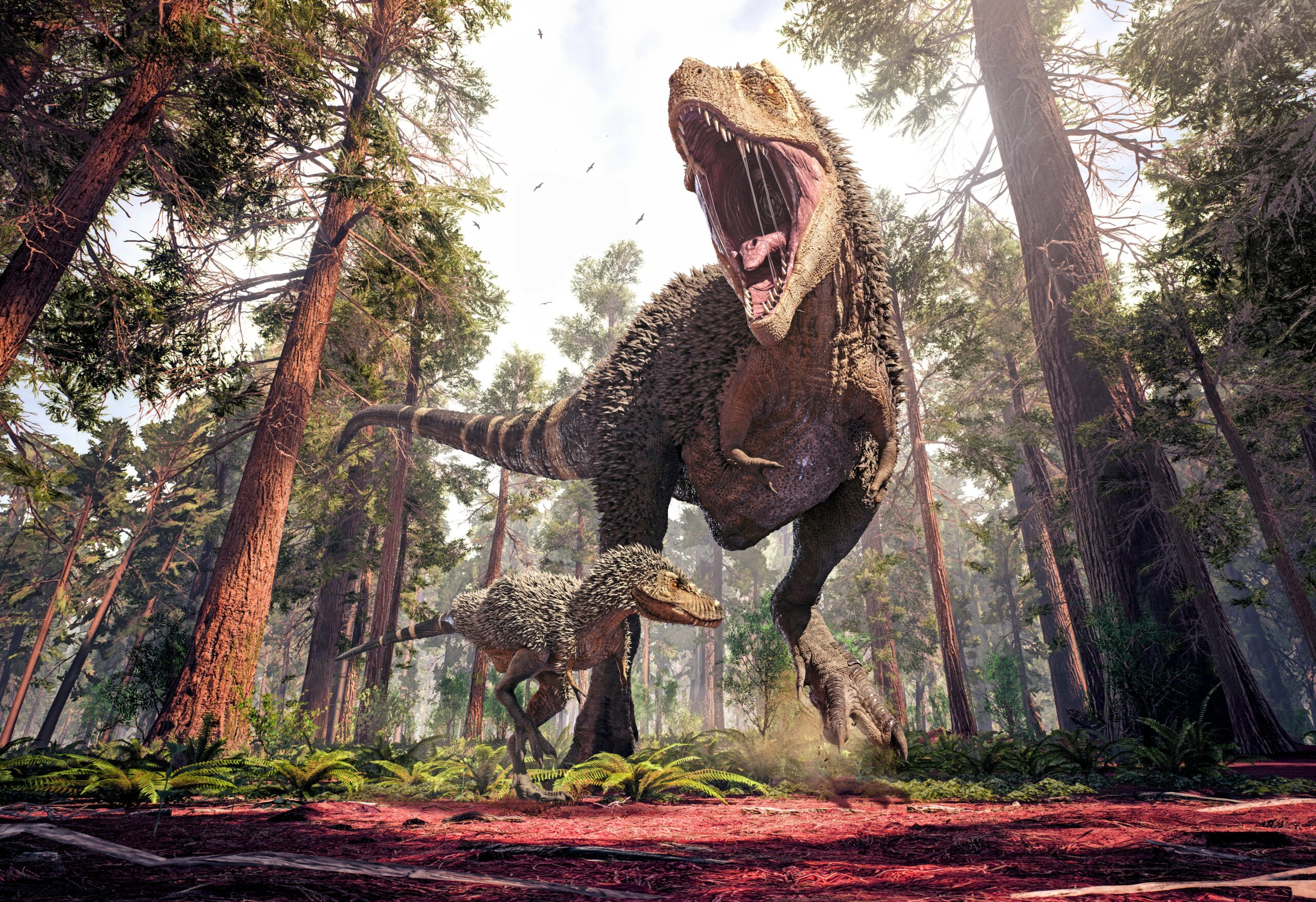
Credit: www.earth.com
Social Behavior And Group Dynamics
Delving into the Social Behavior and Group Dynamics of the mighty T. Rex reveals a fascinating glimpse into the lives of these prehistoric giants. How they interacted with each other has always been a source of wonder for paleontologists.
Evidence Of Pack Hunting Vs Solitary Lifestyle
Did T. Rex dinosaurs hunt alone or in packs? This question captivates many. Scientists study fossil clues to find the answer.
Some intriguing discoveries suggest T. Rex may have hunted in groups. Fossil sites with multiple T. Rex skeletons support this theory. Yet, not all experts agree.
Many argue that these dinosaurs were solitary predators. The debate continues as new evidence emerges.
| Pack Hunting Clues | Solitary Lifestyle Clues |
|---|---|
| Group fossil finds | Isolated skeletal remains |
| Bite marks on prey bones | Territorial displays in fossils |
| Similar aged tracks together | Evidence of aggressive encounters |
Communication And Territoriality Among T. Rex
How T. Rex communicated remains a mystery. Fossilized footprints hint at complex behaviors.
Vocalizations might have echoed through the Cretaceous forests. Deep, powerful growls perhaps warned rivals or called to mates. Without direct evidence, these are educated guesses.
- Body language could signal different messages.
- Scent marking likely played a role in claiming territory.
- Battles scars on skulls point to fierce territorial fights.
Insights into these behaviors come from comparing T. Rex to modern animals. Birds and crocodiles are their closest living relatives.
Both use complex communication and defend their space. T. Rex might have done the same, on a much larger scale.
Challenges And Dangers In The Cretaceous Period
The Cretaceous Period was a time of immense change and danger for the creatures that roamed our planet. None faced a more daunting world than the mighty Tyrannosaurus rex, King of the dinosaurs.
For T. Rex, survival was a daily challenge, brimming with threats from competition, natural predators, and cataclysmic environmental events. Understanding these challenges is key to imagining the life of T. Rex in the prehistoric wilds.
Natural Predators And Competitors Of T. Rex
The Tyrannosaurus rex was a top predator, but it wasn’t without competition. Younger, smaller T. Rexes faced threats from other predators.
Packs of dromaeosaurids, like those of the agile velociraptor, could have posed a danger to juvenile T. Rexes unable to defend themselves against a coordinated attack.
Rival species also competed for food and territory. Large ceratopsians such as Triceratops, and armored ankylosaurs, could fend off T. Rex attacks with their size and weaponry.
Carnivorous contemporaries like Allosaurus or Acrocanthosaurus could challenge T. Rex for supremacy in certain regions.
Environmental Events That Affected T. Rex Populations
Environmental calamities were common during the Cretaceous Period. Volcanic eruptions, climate shifts, and potential asteroid impacts changed the landscape dramatically. These changes challenged the T. Rex’s survival.
Volcanic eruptions could destroy habitats, leading to food shortages. Climate shifts might transform a lush jungle into an arid desert. T. Rex had to adapt or move to survive.
The end of the Cretaceous Period saw the most catastrophic event: the asteroid impact. It is believed to have caused the mass extinction that ended the reign of the dinosaurs.
T. Rex, like others, fell victim to this rapid change in global conditions.
| Type of Event | Impact on T. Rex |
|---|---|
| Volcanic Eruptions | Destroyed habitats and food sources |
| Climate Shifts | Forced migrations and adaptation |
| Asteroid Impact | Contributed to mass extinction |
Extinction And Its Aftermath
The mighty Tyrannosaurus rex once roamed the earth as a formidable predator. Its sudden disappearance from our planet’s tapestry of life still intrigues many.
This section delves into the extinction of the T. rex and the ripple effects on prehistoric ecosystems and our understanding of this incredible creature through fossil records.
Theories Behind The Disappearance Of T. Rex
Various theories attempt to explain the sudden exit of T. rex from the stage of life over 65 million years ago.
Here, we explore the leading hypotheses that scientists have proposed over the years:
- A catastrophic asteroid impact known as the Cretaceous-Paleogene extinction event.
- Massive volcanic eruptions that changed the climate and landscape.
- Shifts in sea levels and climate change leading to drastic habitat alterations.
- Diseases or parasitic infections that could have spread rapidly among species.
Impact On Ecosystems And The Fossil Record
The disappearance of the top predators like T. rex caused a significant shift in the ancient ecosystems.
As the balance of the food chain was disrupted, new species of flora and fauna emerged. The fossil record stands as a testament to this transition, offering clues to the past.
Here are the key consequences revealed through paleontological discoveries:
| Impact on Ecosystems | Fossil Record Insights |
|---|---|
| Emergence of smaller predators | More diverse dinosaur species towards the end of the Cretaceous period |
| New plant-eating dinosaurs flourished | Denser vegetation and plant variety in fossils |
| Extinction of certain pre-existing species | Disappearance of certain dinosaur species in upper stratigraphic layers |
| Adaptive radiation of mammals | Increases in mammal fossils post-T. rex era |
How Did T. Rex’s Teeth Help Them Survive in Their Natural Habitat?
T. Rex, the dinosaur with over 500 teeth, used their impressive dental arsenal to hunt and devour prey in their natural habitat. Their razor-sharp teeth were perfect for tearing flesh and crushing bones, giving them a significant advantage in the prehistoric food chain.
What Were the Predatory Behaviors of T. Rex Dinosaurs in Their Natural Habitat?
The T. Rex dinosaur daily habits guide includes predatory behaviors in its natural habitat. T. Rex displayed aggression and dominance to secure food. They used their powerful jaws to tear through flesh and crush bones. Their keen senses and agility made them efficient hunters in their ecosystem.
Did T. Rex Dinosaurs Have Any Natural Predators?
The existence of T. Rex dinosaurs instills awe, but did they encounter any natural predators? Fossil records and scientific research indicate that these colossal creatures reigned over their habitats without sharing the land with any predators. However, if we could miraculously find areas with dinosaurs still alive, perhaps these apex predators would have met their equals in other gigantic carnivorous species.
Frequently Asked Questions Of How Did T. Rex Dinosaurs Live In Their Natural Habitat?
How Did The T. Rex Adapt To Its Habitat?
The T. rex adapted through powerful jaws, sharp teeth, and strong legs for hunting prey in its Cretaceous ecosystem. Its keen sense of smell helped locate food sources, while its massive size deterred predators.
What Is A T. Rex’s Diet?
A T. rex primarily fed on other dinosaurs, being a carnivorous predator. It was at the top of the food chain.
What Was The Lifestyle Of The T. Rex?
The T. rex was a carnivorous dinosaur, living a solitary predatory lifestyle. It likely scavenged and actively hunted large prey, using its powerful jaws and sharp teeth as key survival tools in the Cretaceous ecosystem.
Did The Tyrannosaurus Rex Live?
Yes, the Tyrannosaurus rex lived around 68 to 66 million years ago during the late Cretaceous period.
Conclusion
Exploring the life of T. Rex has been a journey through prehistoric times. These formidable dinosaurs dominated their landscape, adapting perfectly to their surroundings. Their behavior and habitat preferences reveal much about their survival tactics.
We have gleaned insights into their world, piecing together their existence from fossils and scientific deduction.
Remember, understanding the past is crucial to our knowledge of Earth’s vast history.

